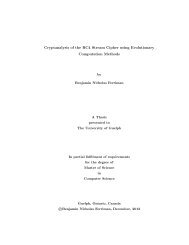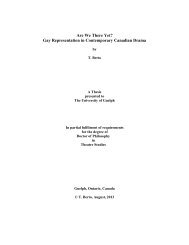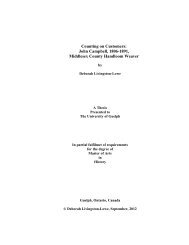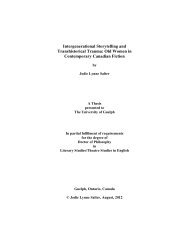THESIS - ROC CH ... - FINAL - resubmission.pdf - University of Guelph
THESIS - ROC CH ... - FINAL - resubmission.pdf - University of Guelph
THESIS - ROC CH ... - FINAL - resubmission.pdf - University of Guelph
Create successful ePaper yourself
Turn your PDF publications into a flip-book with our unique Google optimized e-Paper software.
concentrations at isolated sites. A reduced surface area <strong>of</strong> aggregates would also lead to a<br />
decrease in interfacial interaction. Films harboring these flaws under tension would ultimately<br />
result in premature failure.<br />
Elongation at Break (%)<br />
300<br />
250<br />
200<br />
150<br />
100<br />
50<br />
0<br />
43% RH<br />
60% RH<br />
84% RH<br />
0 CNF 0.25 CF 0.25 CF 0.5 CF 1 CF 2.5<br />
Fiber Content (% w/w SPI)<br />
Figure 6.8: Elongation with respect to fiber content and relative humidity<br />
These results suggest that the optimal fiber loading for the extracted cellulose should be<br />
around 0.25%. This can be attributed to the lack <strong>of</strong> aggregates present in combination with<br />
homogenous dispersion <strong>of</strong> fibers observed. With even mixing, load transfers upon tension on<br />
plastic film could be applied to the stronger cellulose fibers for enhanced reinforcement.<br />
Evidence <strong>of</strong> strong interactions between cellulose and SPI was suggested through the results<br />
and does concur with current literature. However, marked improvement on mechanical<br />
properties was mainly hindered by the natural self-association <strong>of</strong> cellulose fibers.<br />
79

















